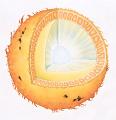Ordering the universe
ALMOST EVERYANCIENT CULTURE recognized the Sun as the giver of life and primary power behind events here on Earth. The Sun is the center of our solar system, our local star. It has no permanent features because it is gaseous-mainly incandescent hydrogen. The temperature of the Sun's visible yellow disk-the photosphere-is about 9,900oP (5,500°C). Over the photosphere, there are layers of hotter gas-the chromosphere and corona. The thin gas in the corona is at about a million degrees. By using spectroscopic analysis (pp.30-31), scientists know that the Sun, like most stars (pp.60-61), is made up mostly of hydrogen. In its core, the hydrogen nuclei are so compressed that they eventually fuse into helium. This is the same thing that happens in a hydrogen atomic bomb. Every minute, the Sun converts 240 million metric tons of mass into energy. Albert Einstein's famous formula, E=mc2, shows how mass and energy are mutually interchangeable, helping scientists to understand the source of the Sun's energy. Read some facts about Saturn below, or click here.
The Coronagraph
In 1930 the French astronomer Bernard Lyot (1897-1952) invented the coronagraph. It allows the Sun's corona to be viewed without waiting for a total solar eclipse.
Viewing the Sun
Even though the Sun is more than 93 million miles (149 million km) from Earth, its rays are still brightenough to damage the eyes permanently. The Sun should never be viewed directly and certainly not through a telescope or binoculars. Galileo went blind looking at the Sun. This astronomer is at the Kitt Peak National Observatory in Arizona. Two mirrors at the top of the solar telescope tower reflect the Sun's image down a tube to the mirror below. Inside the tube there is a vacuum. This prevents distortion that would be caused by the air in the tower.
The Dipleidoscope
Local noon occurs when the Sun crosses the local north-south meridian (p.27). In the 19th century a more accurate device than the gnomon was sought to indicate when noon occurred. The dipleidoscope, invented in 1842, is an instrument with a hollow, right-angled prism, which has two silvered sides and one clear side. As the Sun passes directly overhead, the two reflected images are resolved into a single one. This shows when it is local noon.
Changing Seasons
The seasons change because Earth rotates on a north-south axis as it orbits the Sun. The axis is tilted at an angle of 23W. When the South Pole is tilted toward the Sun, the southern hemisphere experiences summer and the northern hemisphere winter. The path of the Sun across the sky also changes because of this tilt. It is lower in winter, and the days are shorter, and higher in the summer when the days are longer. Countries close to the equator do not have such extremes of temperature or changes in the length of day.
The Corona
The outermost layer of the Sun's atmosphere is called the corona. Even though it extends millions of miles into space, it cannot be seen during the day because of the brightness of the blue sky. During a total eclipse, the corona appears like a crown around the Moon. It is clearly seen in this picture of a total eclipse over Mexico in March 1970.
Solar Eclipse
A solar eclipse happens when the Moon passes directly between Earth and the Sun, casting a shadow on the surface of Earth. From an earthly perspective, it looks as if the Moon has blocked out the light of the Sun. Total eclipses of the Sun are very rare in any given location, occurring roughly once every360 years in the same place. However, several solar eclipses may occur each year.
Sunspots
Sunspots are cooler areas on the Sun, where strong magnetic fields disturb the flow of heat from the core to the photosphere. Typical sunspots last about a week and are twice as big as Earth. They often form in pairs or groups. The number of sunspots appearing on the Sun rises and falls over an II-year period. This is called the solar cycle. At sunspot maximum, the Sun also experiences large explosive eruptions called flares, which blast streams of particles into space.
Plotting the Sunspots
By observing the changing position of sunspots, we can see that the Sun is spinning. Unlike the planets, however, the whole mass of the Sun does not spin at the same rate because it is not solid. The Sun's equator takes 25 Earth days to make one complete rotation. The Sun's poles take nearly 30 days to accomplish the same task. These photographs are a record of the movements of a large spot group over 14 days in March/April1947.
Coronal Loops
AHuge loops of very hot gas surge through the Sun's corona, guided by the magnetic field."These loops are about 30 times larger than Earth. This picture was taken from space in extreme ultraviolet light by NASA's TRACEsatellite, launched in 1998 to study the Sun.
Solar Prominence
Astronomers have learned much about the Sun from solar observatories operating in space, such as SOHO (the Solar and Heliospheric Observatory). This SOHO image of the Sun shows ultraviolet light from the chromosphere, a layer of hot gas above the yellow disk of the Sun we normally see. A huge prominence is erupting into the corona. Prominences like this usually last a few hours. They can fall back down or break off and cause gas to stream into space. Sometimes, the corona blasts huge clouds of gas into space. If one of these coronal mass ejections reaches Earth, it may cause a magnetic storm and trigger an aurora (northern or southern lights).
Facts about the Sun
- Equatorial diameter 0.86 million miles/1.4million km
- Distance from Earth 93 million miles/ 149 million km
- Rotational period 25 Earth days
- Volume (Earth = 1) 1,306,000
- Mass (Earth = 1) 333,000
- Density (water = 1) 1.41
- Temperature at surface 9,900°F (5,500°C)





